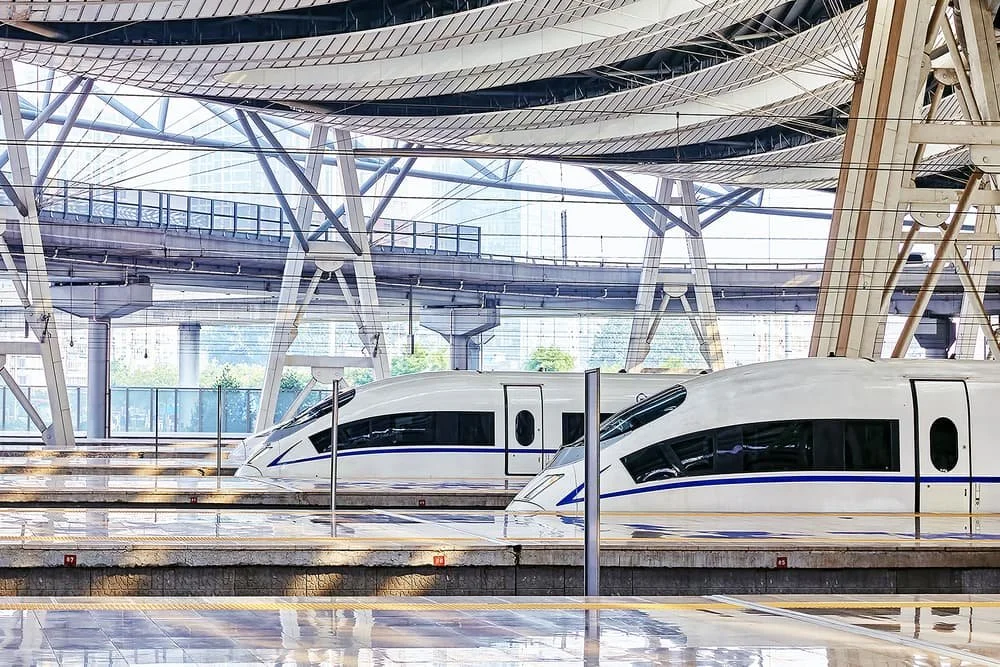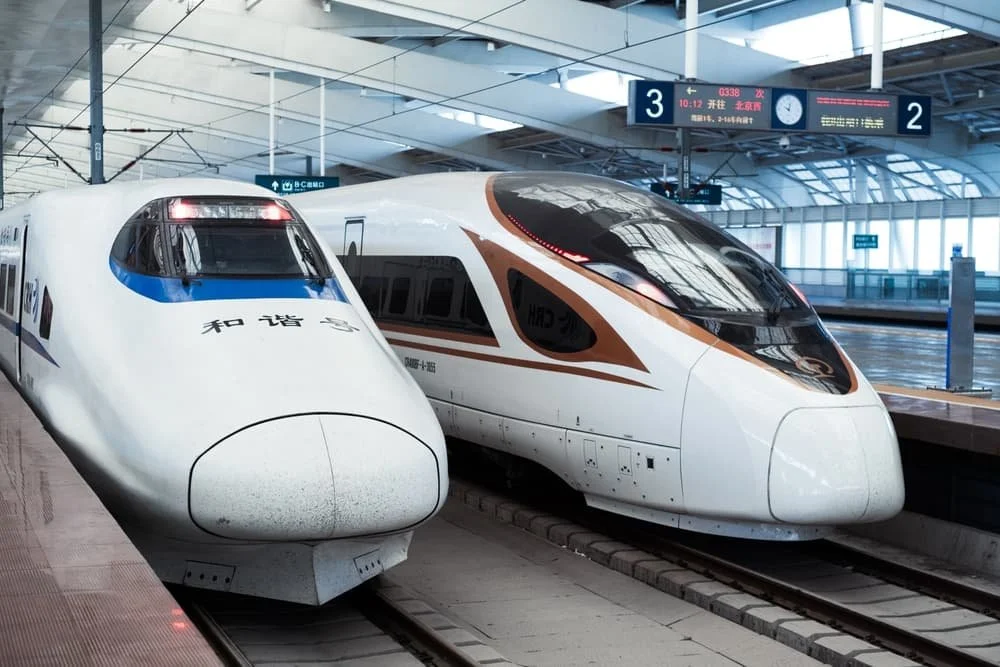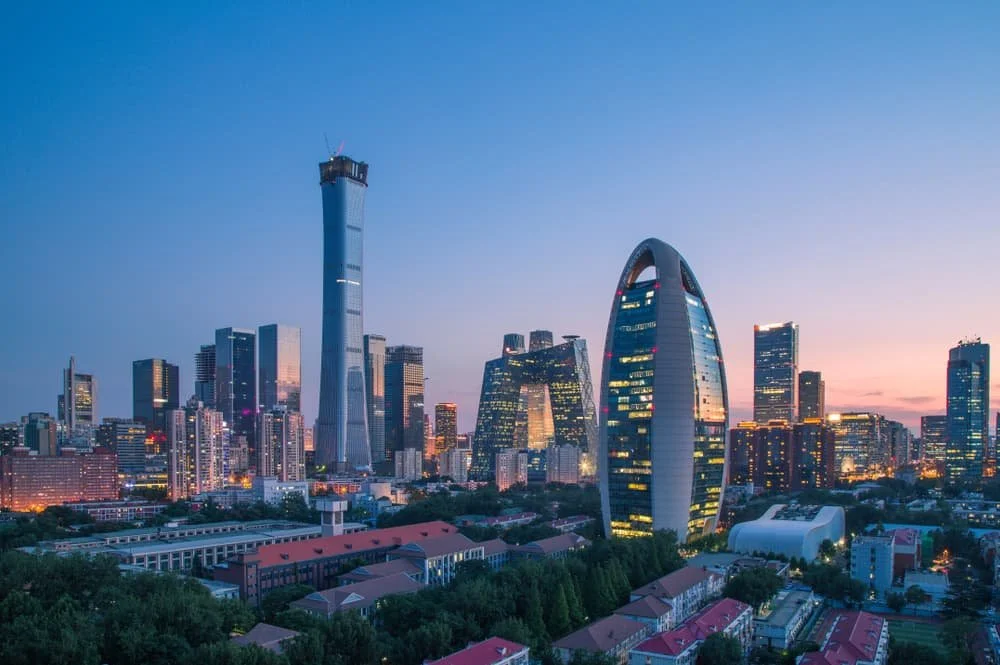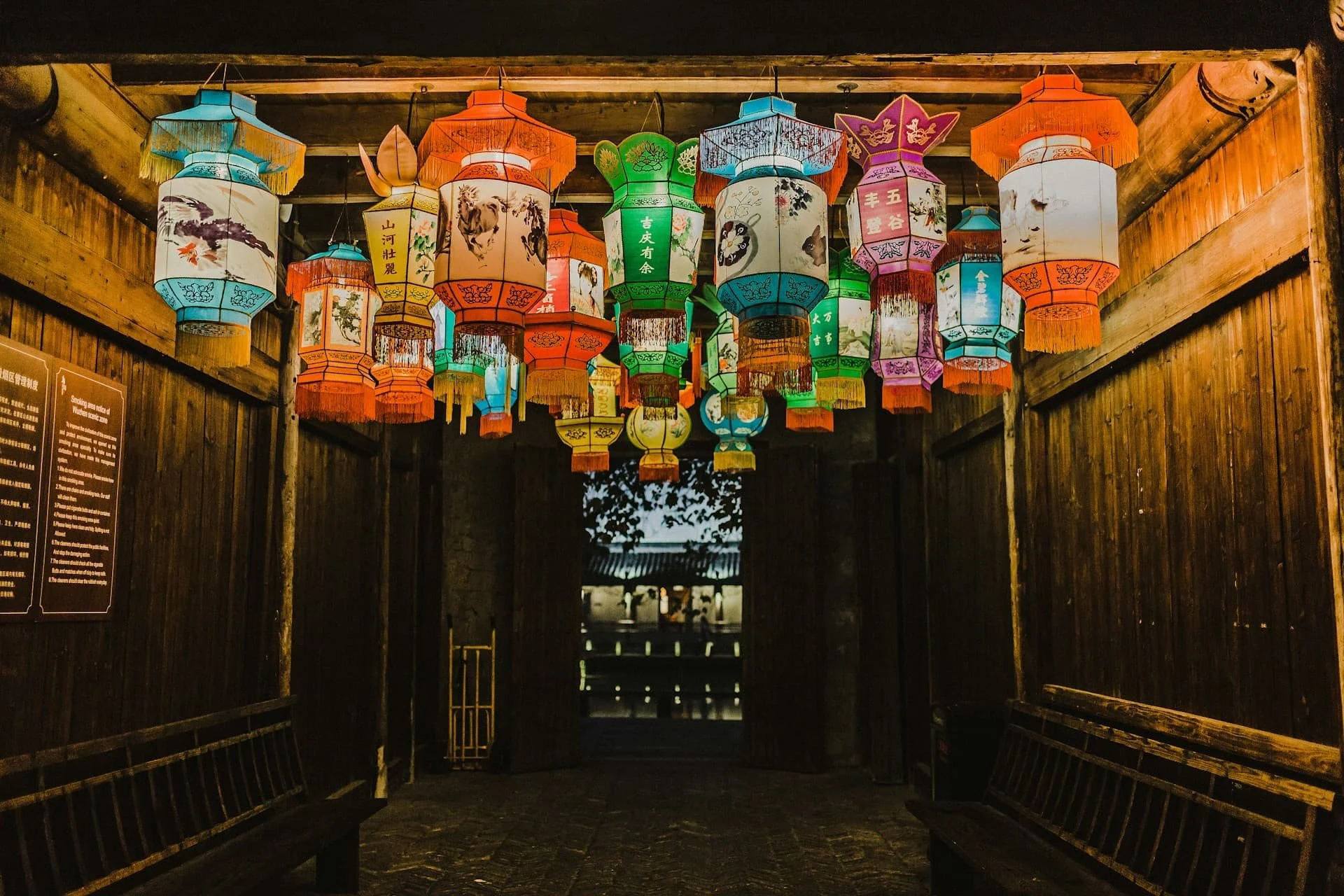A Complete Guide to High-Speed Rail in China
China’s high-speed rail is the fastest, easiest way to cross the country.
V_E / Shutterstock
If you want to eat soup dumplings in Shanghai at lunch and be back in Beijing for a late show, you ride the trains. China has built the most extensive high-speed network on Earth, connecting megacities and mountain towns with glassy stations and carbon-miserly trains that routinely hit airline-rattling speeds.
This guide is the straight-talking version you actually need: how to book on the official system, what the classes mean, where to sit, when to show up, what to do at security, and the routes that make the most sense for travellers.
What “High-Speed” Really Means Here
China’s top-tier “Fuxing” sets cruise at up to 350 km/h on flagship corridors, which is where the magic happens for travellers trying to pack two cities into a day. The network keeps expanding, with officials confirming more than 48,000 km of dedicated high-speed lines in service by the end of 2024, and more still coming.
If you like peeking around the corner at tomorrow, the government even rolled out a 400 km/h CR450 prototype to future-proof the fleet. The point is simple: this isn’t a novelty train set; it’s the country’s default long-distance backbone. 12306 China Railway’s English site is the official front door for tickets and rules, and it works.
For context and current scale, the State Council’s transport updates are the government-level pulse on what’s open and how fast. If you want proof this system can absorb crowds, note that national holiday travel records are set by rail, not air—these trains carry the load.
Decoding Train Types, Seats and Speeds
Andrei Iakhniuk / Shutterstock
Look for a letter before your train number. “G” is the fastest tier with the slickest rolling stock and the highest number of departures on prime routes. “D” trains are slightly slower but still quick and sometimes include overnight sleepers on longer hauls. “C” runs are shorter intercity hops around big conurbations. Inside the train, classes are intuitive. Second Class is the value sweet spot with a 3–2 seating layout. First Class drops to a 2–2 layout with more elbow room and quieter carriages. Business Class is the swish 2–1 layout with almost-flat recliners facing huge windows; you’ll find it on the star corridors such as Beijing–Shanghai.
If you want a vivid sense of typical journey times, the independent, veteran rail resource at The Man in Seat 61 tracks the big-name routes and the current best timings in plain English. Pair that with the live schedules on 12306 and you’ll plan like a pro.
The Two Bookings That Actually Work
If you’re travelling wholly within mainland China, book on 12306. It has an English interface, accepts passports for real-name ticketing, shows live inventory, and—crucially—lets you change or refund under the official rules rather than a reseller’s fine print. Sales windows can vary, but cross-boundary guidance confirms tickets often appear within a 15-day window, and the official site shows its own operating hours and after-sales rules clearly.
If your trip includes Hong Kong, the cross-boundary section is seamlessly tied into the mainland system and supported by the operator in Hong Kong. Use the MTR’s dedicated high-speed hub to understand classes, fares, baggage and the real-name policy before you click through to buy.
Don’t be tempted by unofficial rail booking sites or local ticket sellers outside the station – the tickets probably won’t be real, and you could end up being questioned by station security.
How to Navigate Big Stations Without Stress
QINQIE99 / Shutterstock
Think airport logic minus the liquids rule. Arrive 45–60 minutes ahead at the mega-hubs such as Beijing South and Shanghai Hongqiao to clear the quick security scan and find your gate. The boarding gates close a few minutes before departure and the trains leave on the dot. Transfer times are baked into the hubs; for instance, Shanghai Hongqiao is welded to the metro and airport, so switching from city train to intercity bullet is as painless as Chinese transport gets. In Hong Kong, West Kowloon’s high-speed hub is designed for international travellers, with English signage and clear flows to immigration and customs.
Luggage is surprisingly civilised. You roll your bag through scanners at the entrance and keep it with you on board, sliding carry-ons above, or parking larger cases at the carriage ends. Cross-boundary baggage allowances and special-item rules are spelled out on the MTR’s high-speed pages; mainland rules are enforced by station security and are more about banned items than grams and centimetres, so think common sense and you’ll be fine.
Where to Sit and Why It Matters
If you’re taking a marquee route and you want that “I am in the future” panorama, Business Class is worth it once—especially on the arrow-straight Beijing–Shanghai line. If you’d rather save your yuan for a great dinner, First Class gives you the silence and power outlets with more shoulder room than economy on a plane. Families are perfectly happy in Second Class, and the ride quality is so smooth you’ll forget you’re doing 300+.
Window seats are the move for first-timers, but pay attention to the side if you want skyline hits. On Shanghai approaches, Pudong pops better on the right-hand side heading in from the south; in Guangzhou, the Pearl River skyline pulls focus as you glide towards Zhujiang New Town on certain approaches.
China Train Journeys to Consider
Beijing - Shanghai
Tang Yan Song / Shutterstock
Beijing–Shanghai is the one everyone talks about, and for good reason. It’s under five hours on the fastest “G” trains, and the clockwork reliability of departures makes it feel almost like a metro that happens to cross 1,300 kilometres of country. Use the morning sprint to drop into the French Concession for lunch, then ride back with the sunset slanting off the rice paddies and solar farms. If you plan to stay the night, lean central and design-forward at The Middle House or go Bund-side and old-Shanghai glam at the Fairmont Peace Hotel.
Beijing – Xi’an
Beijing–Xi’an is the culture highway. In four-and-a-bit hours you go from imperial brick to Qin dynasty terracotta. Book terracotta tickets in advance via the museum’s official platform and read the capacity and real-name notes so you sail past the tour-group scrum. If you’re making it an overnight, the big, playful option with resort-style leisure is W Xi’an. If you’re blasting back the same day, take a late “G” train and dinner from the station convenience stores. The snack game is weirdly solid.
Guangzhou - Guilin
Maria_Usp / Shutterstock
Guangzhou–Guilin is your green-on-green window seat. In roughly two and a half hours you pass from glass towers to karst peaks that look stolen from a classical scroll. The city itself is practical rather than atmospheric, so make your base in the scenery. The most sensible splurge in Guangzhou, if you do stage there, is the Four Seasons Hotel Guangzhou for the views and the pool that appears to be suspended in the sky.
Hangzhou – Huangshan
Hangzhou–Huangshan is the smartest way to turn a city break into a mountain finale. The high-speed line feeds directly toward Yellow Mountain trailheads, trimming ground time and making an overnight at the base realistic without the bus shuffle. There’s good government-level reporting on how this corridor was deliberately built for tourism access. Combine it with a day around West Lake, then roll into Huangshan North and up to the trail start after an early noodle stop.
Chengdu – Chongqing
Chengdu–Chongqing is a chef’s kiss for food-motivated travellers. Think 60–80 minutes of river cuts, bridges and high-speed weaving between two of China’s most tasty cities. In Chengdu, base near Taikoo Li for easy evenings, and yes, The Temple House earns its design-nerd reputation with courtyards and a spa you will not want to leave.
If you’re airport-hopping in Shanghai and just want to nerd out for ten minutes, the city’s separate maglev is still a party trick. It’s not part of the national high-speed network, but it rockets between Pudong Airport and Longyang Road with that sci-fi glide. Check the timetable and fares on the official maglev site and time it for a top-speed run.
Food, Coffee and the Lost Art of a Good Station Hour
Victoria Labadie / Shutterstock
Stations are cities now. In Shanghai Hongqiao you can eat decent biangbiang noodles, grab a strong latte and still have time to stroll the departure hall and gawk at the roof trusses. Beijing South’s concourse is all clean sightlines and LED boards that make everything obvious even if you don’t read Chinese.
English is present; icons are universal. If you’re the type who likes to engineer delight, pack a mini picnic from a supermarket before you board: fresh fruit, a couple of bakery pieces, a cold tea. The onboard trolley exists, but selection is hit-and-miss.
How to Glide Through Ticketing Without Tears
All mainland tickets are real-name, which means you must book with the exact passport details you’ll use to travel. On the day, bring that passport. If you bought through 12306, you can usually go straight to the gates in major stations where staff scan your passport if the automatic gates don’t.
If you booked a cross-boundary service into or out of Hong Kong, the MTR high-speed pages explain the document types and the 12306 tie-in very clearly. Refunds and changes are rule-bound on the official system and the fees are transparent. It’s also where any disruption notices appear first.
How Early to Arrive, and What Security Is Like
NG-Spacetime / Shutterstock
Treat departures like a domestic flight without the stress. You enter through security where your bag goes through a scanner. Keep batteries and power banks visible if asked. Knives and aerosols are a no. Water is typically fine. Once inside the sterile area, follow the gate displayed on the boards; when the platform opens, scan and go straight to your carriage.
If you’re changing trains within a huge hub—say a metro to high-speed connection at Hongqiao—add ten minutes to your mental buffer – that photo above is actually taken at a relatively quiet time!
If you’re arriving from the airport, 45 minutes is still comfortable if you have a metro card and you’re not shepherding a rugby team.
Power, Wi-Fi and Staying Sane
Outlets are common. Wi-Fi varies by route and operator and is best treated as a pleasant surprise rather than the backbone of your workday. Download your podcasts beforehand, and stash a short charging cable in your daypack. Trains are quiet by design; phone calls and TikTok binges without headphones will earn you the look.
Sustainability Without the Slog
kikujungboy CC / Shutterstock
If you compare like-for-like trips, the emissions profile of a high-speed train versus a short-haul flight is heavily in the train’s favour. China’s newest high-speed lines are designed as mass-transit arteries where pathing and signalling keep steel wheels humming with minimal idling. You don’t need a treatise on grid carbon intensity to feel good about choosing a two-to-five-hour train over a flight.
A Few Working-Day Itineraries You Can Actually Do
Beijing breakfast, Shanghai lunch, Beijing theatre works better on a train than a plane. Take an early “G” from Beijing South, drop your bag at the hotel, slurp xiaolongbao and pop into a gallery in the former French Concession, then ride back on a twilight service. Guangzhou to Guilin for a single day on the Li River is equally sane; the return timings are frequent enough that you don’t need to panic about missing the last train. Chengdu to Chongqing for hotpot and skyline photos is practically a commuter move. And if you’re crossing in and out of Hong Kong, West Kowloon’s cross-boundary services are built precisely for the day-trip impulse.
The One Nerdy Detour Worth Your Time
Markus Mainka / Shutterstock
If you like future-leaning transport, pencil in a ten-minute fangirl moment for Shanghai’s maglev. It’s not a practical intercity route, but the acceleration is pure theatre and it delivers you to the metro in a flash.
For a longer read on where global high-speed is heading, the International Union of Railways maintains a useful, plain-English overview of tech and trends. And if you’re into what’s next on China’s rails specifically, the official note on the CR450 prototype is a tidy peek at the next speed bump.



















